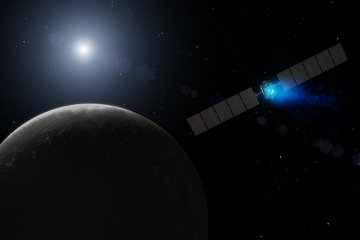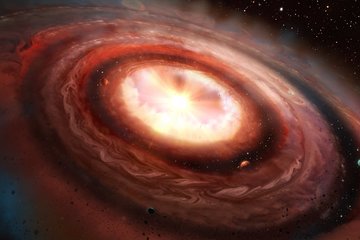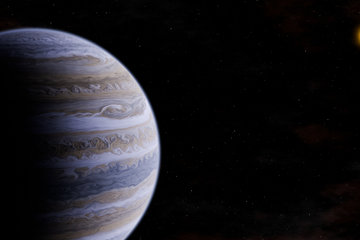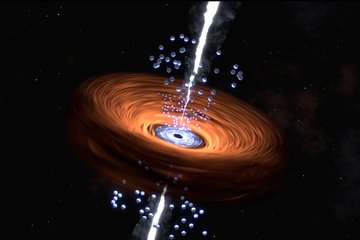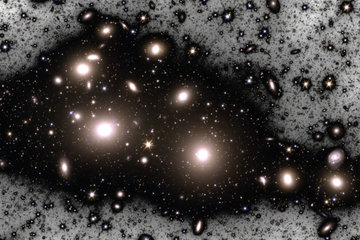Astronomers find the nearest massive black hole
With 8200 solar masses, the black hole fills the evolutionary gap between stellar and supermassive black holes
Newly identified fast-moving stars in the star cluster Omega Centauri provide solid evidence for a central black hole in the cluster. With at least 8200 solar masses, it is the best candidate for a class of black holes astronomers have long believed to exist: intermediate-mass black holes, formed in the early stages of galaxy evolution. The discovery bolsters the case for Omega Centauri as the core region of a galaxy that was swallowed by the Milky Way billions of years ago. Stripped of its outer stars, that galaxy nucleus has remained “frozen in time” since then. The study has been published in the journal Nature.

Omega Centauri is a spectacular collection of about ten million stars, visible as a smudge in the night sky from Southern latitudes. Through a small telescope, it looks no different from other so-called globular clusters: a spherical collection of stars, so dense towards the centre that it becomes impossible to distinguish individual stars. But now a new study, led by Maximilian Häberle (Max Planck Institute for Astronomy), confirms what astronomers had been suspecting for some time: Omega Centauri contains a central black hole. The black hole appears to be the “missing link” between its stellar and supermassive kin: Stuck in an intermediate stage of evolution, it is considerably less massive than typical black holes in the centres of galaxies. Omega Centauri seems to be the core of a small, separate galaxy whose evolution was cut short when the Milky Way swallowed it.
A range of black hole masses
In astronomy, black holes come in different mass ranges. Stellar black holes, between one and a few dozen solar masses, are well known, as are the supermassive black holes with masses of millions or even billions of Suns. Our current picture of galaxy evolution posits that the earliest galaxies should have had intermediate-sized central black holes, which would have grown over time as those galaxies evolved, gobbling up smaller galaxies (as our Milky Way has done) or merging with larger galaxies.
Such medium-sized black holes are notoriously hard to find. Galaxies like our own Milky Way have long outgrown that intermediate phase and now contain much larger central black holes. Galaxies that have remained small (“dwarf galaxies”) are generally difficult to observe. With the currently available technology, observations of their central regions that could detect the central black hole are extremely challenging. Although there are promising candidates, there has been no definite detection of such an intermediate-mass black hole – until now.
A galaxy (core) frozen in time
This is where Omega Centauri is special. If it was once the core of a separate galaxy, which then merged with the Milky Way and lost all but its central batch of stars in the process, the remaining galactic core and its central black hole would be "frozen in time": There would be no further mergers, and no way for the central black hole to grow. The black hole would be preserved at the size it had when Omega Centauri was swallowed up by the Milky Way, providing a glimpse of the missing link between early low-mass black holes and the later supermassive black holes.
To test this hypothesis, it is necessary to actually detect a central black hole in Omega Centauri, and a definite detection had eluded astronomers until now. While there was evidence from large-scale models of the motion of stars in the cluster, that evidence left room for doubt: Maybe there was no central black hole at all.
Needle in an archival haystack
Zoom onto the black hole in the center of Omega Centauri
When Nadine Neumayer, a group leader at the Max Planck Institute for Astronomy, and Anil Seth of the University of Utah designed a research project aimed at an improved understanding of the formation history of Omega Centauri in 2019, they realized that here was an opportunity to settle the question of the cluster’s central black hole once and for all: If they were able to identify the expected fast-moving stars around a black hole in the centre of Omega Centauri, that would be the proverbial smoking gun, as well as a way of measuring the black hole's mass.
The arduous search became the task of Maximilian Häberle, a PhD student at the Max-Planck Institute for Astronomy. Häberle led the work of creating an enormous catalogue for the motions of stars in Omega Centauri, measuring the velocities of 1.4 million stars by studying over 500 Hubble images of the cluster. Most of these images had been produced for the purpose of calibrating Hubble’s instruments rather than for scientific use. But with their ever-repeating views of Omega Centauri, they turned out to be the ideal data set for the team’s research efforts.
Häberle says: “Looking for high-speed stars and documenting their motion was the proverbial search for a needle in a haystack.” But in the end, Häberle not only had the most complete catalogue of the motion of stars in Omega Centauri yet (published in a separate article). He had also found not one but seven needles in his archival haystack: seven tell-tale, fast-moving stars in a small region in the centre of Omega Centauri.
Uncovering a black hole
Hubble observes star movements in Omega Centauri
Those fast-moving stars are fast because of the presence of a concentrated nearby mass. For a single star, it would be impossible to tell whether it is fast because the central mass is large or because the star is very close to the central mass – or if the star is merely flying straight, with no mass in sight. But seven such stars, with different speeds and directions of motion, allowed Häberle and his colleagues to separate the different effects and to determine that there is a central mass in Omega Centauri, with a mass of at least 8,200 suns. The images do not indicate any visible object at the inferred location of that central mass, as one would expect for a black hole.
The broader analysis not only enabled Häberle to pinpoint the speeds of his seven high-speed stars. It also narrowed down the location of just where the central region, three light-months in diameter (on images, three arc seconds), is located within Omega Centauri. In addition, the analysis provided statistical reassurance: A single high-speed star in the image might not even belong to Omega Centauri. It could be a star outside the cluster that passes right behind or in front of Omega Centauri's centre by chance. The observations of seven such stars, on the other hand, cannot be pure coincidence and leave no room for explanations other than a black hole.
An intermediate-mass black hole at last
Neumayer says: “Previous studies had prompted critical questions of ‘So where are the high-speed stars?’ We now have an answer to that and the confirmation that Omega Centauri contains an intermediate-mass black hole. At a distance of about 18,000 light-years, this is the closest known example of a massive black hole.” The supermassive black hole in the centre of the Milky Way is at a distance of about 27,000 light-years. This detection not only promises to resolve the decade-long debate about an intermediate-mass black hole in Omega Centauri. It also provides the best candidate so far for the detection of an intermedia-mass black hole in general.
Given their findings, Neumayer, Häberle and their colleagues now plan to examine the centre of Omega Centauri in even more detail. They already have approval for measuring the high-speed star's movement towards or away from Earth (line-of-sight velocity) using the James Webb Space Telescope, and there are future instruments (GRAVITY+ at ESO's VLT, MICADO at the Extremely Large Telescope) that could pinpoint stellar positions even more accurately than Hubble. The long-term goal is to determine how the stars accelerate: how their orbits curve. Following those stars once around their whole orbit, as in the Nobel-prize-winning observations near the black hole in the centre of the Milky Way, is a project for future generations of astronomers, though. The smaller black hole mass for Omega Centauri means ten times larger time scales than for the Milky Way: orbital periods of more than a hundred years.
Background information
The work described here has been published as M. Häberle et al., “Fast-moving stars around an intermediate-mass black hole in ω Centauri” in the journal Nature. The star catalogue on which the work is based has been accepted for publication as M. Häberle et al., "oMEGACat II — Photometry and proper motions for 1.4 million stars in Omega Centauri and its rotation in the plane of the sky" in the Astrophysical Journal.
The MPIA scientists involved are Maximilian Häberle, Nadine Neumayer, Antoine Dumont, Callie Clontz (also University of Utah), Anja Feldmeier-Krause (also University of Vienna) and Maria Selina Nitschai,
in collaboration with
Anil Seth (University of Utah), Andrea Bellini (Space Telescope Science Institute), Mattia Libralato (ESA and INAF Padova), Holger Baumgardt (The University of Queensland), Matthew Whitaker (University of Utah), Mayte Alfaro Cuello (Universidad Central de Chile), Jay Anderson (Space Telescope Science Institute), Nikolay Kacharov (Leibniz Institute for Astrophysics Potsdam), Sebastian Kamann (Liverpool John Moores University), Antonino Milone (University of Padova), Renuka Pechetti (Liverpool John Moores University) and Glenn van de Ven (University of Vienna).





